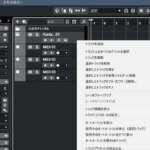EastWest’s Hollywood Orchestra Opus features a humanize function that allows you to easily add fluctuations to your playing.
Using this function, the attack and release timing, pitch, velocity, etc. can be automatically randomized in real time.
Hollywood Orchestra Opus humanizing function
After selecting a voice patch from the Opus browser, open “MIDI TOOLS” in the “PLAY screen” and select “Humanizer” from “+” in the upper right corner of the window.
By setting this tool, the humanizing process will be automatically performed on the voice patch.
The setting items are as follows.
- Note on timing (0 to 100ms)
- Note-off timing (0 to 100ms)
- Velocity (0~50%)
- Tuning (0~100cent)
- Volume (0~100%)
- Panning (0~100%)
Be careful not to over multiply the humanize function
When humanizing MIDI data, one must be careful not to overdo it.
It is often misunderstood that the fluctuations of human performance can not be imitated by simple randomization of MIDI data.
Fluctuations caused by randomization are merely “timing dispersion,” and the more strongly it is applied, the worse the performance becomes.
The ideal is to reproduce the inevitable (and unavoidable) fluctuations that occur when a performer of a certain level or higher tries to achieve just the right timing.
In my case, I keep the randomization of timing to “just barely perceptible” or do not randomize the timing in some cases.
I also do not apply randomization to the timing in the first place. Then, only for phrases of high importance, I perform individual timing expansion and contraction.
Pitch (pitch) randomization should be done carefully
Similarly, be careful not to over-apply pitch randomization, and carefully judge whether or not it is necessary to do so.
In my case, I do not apply pitch randomization to “ensemble tones” such as string sections.
Sectional tones already contain “pitch fluctuation by multiple performers,” so adding more fluctuation to them will cause “all the performers to shift the pitch in the same direction together for each note.
As you can clearly see when you try it with a deeper setting, it goes beyond tone deafness and gives a strong impression of being unnatural and artificial.
Conversely, solo tones and pitch randomization go well together, so try different settings while being careful not to overdo it.


